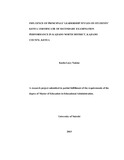| dc.description.abstract | The purpose of this study was to determine the influence of principals’ leadership
styles in students’ performance in Kenya Certificate of Secondary Education in
Kajiado North District, Kajiado County, Kenya. The research objective were
formulated to study the influence of principals’ transformational, transactional
and democratic leadership styles on students’ performance in KCSE in Kajiado
North District. There were 275 teachers and 20 principals in the targeted public
secondary schools. This study employed descriptive survey design to investigate
leadership style in Kenya Certificate of Secondary Education performance.
The sample was 15 principals and 82 teachers, hence a sample size of 97
respondents from the target population. Data was collected using two sets of
questionnaires namely; quantitative analysis was done where the raw scores were
entered into the Statistical Package for Social Science (SPSS) statistical software
to express attitude. Qualitative data was arranged into thematic areas for easy
coding and interpretation. The frequencies of the responses were demonstrated in
figures to express mean and tables to express percentages to communicate
findings in line with the objectives of the study respectively. The study from the
frequency response by the principals revealed that 6 out of 15 principals used
transactional leadership style 5 supported use of transformational leadership style
while 4 of 15 indicated that principals used democratic leadership style 32 out of
80 teachers indicated that principals used transactional leadership style while 25
of them indicated principal use of transformational leadership style, while 23 of
them out of 80 indicated that principal use democratic leadership style. These
frequencies revealed that there was a high use of transactional leadership style
where attendance completion of syllabus short term goal achievement were
emphasized and minimal focused on long term targets, quality of teaching were
least highlighted. In the transformational leadership style, principals stressed the
need to strive towards common goal of fulfilling the school vision and mission,
motivating teachers to go beyond self interest while minimal emphasis was made
on values and symbolic actions. These did not make the schools strive towards
improvement. Teachers felt their principals emphasized on values and
reinforcement on symbolic leadership, display of an appealing personality that
other can emulate but did little to ensure that teachers were part of the school
team that set common goals and vision. This approach could have failed to
compel teachers to be part and parcel of the academic end results in KCSE. The
use of democracy from the principals’ responses indicated that there was high
consultation respect for the rights of the various groups in the school institution
with minimum effort to accord teachers autonomy in decision making about
improving academic performance. Teachers supported that there was high
consultation before decision making, opportunity to contribute on improvement
on KCSE but with less focus on respect for the rights of the various organize
groups and associations in the school. Minimal autonomy and failure to consider
personnel welfare could have contributed towards the below average performance
in KCSE examination. According to principal they used transactional leadership
style to reward teachers for job well done ensure teachers and students do not
pursuit but gave less attention to the fulfillment of long term goals part of which
are KCSE performance. Teachers viewed their principals as leaders who
concentrated on the fulfillment of the short term goals, insistence on KCSE results
improvement but inactive in monitoring the performance of teachers to ensure
value programme ended progress. The study concluded that the use the three
leadership style did not promote improvement in KCSE performance. There was a
significant use of transactional leadership style to insist on short term successes at
the expense of improved KCSE performance. It was recommended that principals
make their personal review of their use of the three leadership styles with a few of
improving KCSE performance which had remained below average for the last
five consecutive years under study. A study on factors that influence students’
KCSE performance other than leadership styles in Kajiado North District. A study
on effect of teachers’ demographics on students’ performance in KCSE. This
study was carried out in Kajiado North District. A similar study can be undertaken
in the other four districts in the county so that a total feel of overall performance
in the county can be highlighted. | en |

